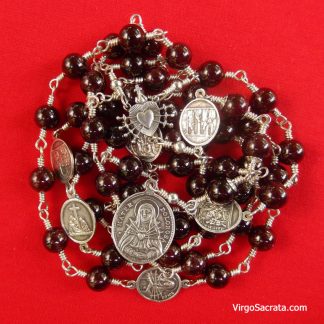
Stabat Mater Dolorosa is considered one of the seven greatest Latin hymns of all time. It is based upon the prophecy of Simeon that a sword was to pierce the heart of Our Lord’s mother, Mary (Lk2:35). The hymn title means “‘Stood the mother, full of grief’.” In Latin, the hymn consists of twenty couplets which describe the Sorrows of the Blessed Virgin at the Cross. The Stabat Mater’s popularity is reflected by its use in the popular devotion of the Stations of the Cross.
The message of the Stabat Mater focuses on the spiritual and emotional bond which unites Mary and all Christians to the death of her Son on the Cross. From this bond, each Christian can recognize the incredible compassion and holiness in Mary’s character. The Blessed Mother demonstrated her maternal compassion to all generations of Christians by her presence and participation with her Son Jesus in the Sacrifice of the Cross.
The Stabat Mater was introduced into the Liturgy gradually until 1727 when it was prescribed as a Sequence for Mass of the Seven Sorrows of Mary on September 15 and on Friday before Holy Week, as well as their corresponding offices. The text of the Stabat Mater has been put to different music by various composers in endless variations.
By Giovanni Battista Pergolesi “Stabat Mater”(1736)
| Stabat Mater dolorosa iuxta Crucem lacrimosa, dum pendebat Filius. | At the Cross her station keeping, stood the mournful Mother weeping, close to Jesus to the last. |
| Cuius animam gementem, contristatam et dolentem pertransivit gladius. | Through her heart, His sorrow sharing, all His bitter anguish bearing, now at length the sword has passed. |
| O quam tristis et afflicta fuit illa benedicta, mater Unigeniti! | O how sad and sore distressed was that Mother, highly blest, of the sole-begotten One. |
| Quae maerebat et dolebat, pia Mater, dum videbat nati poenas inclyti. | Christ above in torment hangs, she beneath beholds the pangs of her dying glorious Son. |
| Quis est homo qui non fleret, matrem Christi si videret in tanto supplicio? | Is there one who would not weep, whelmed in miseries so deep, Christ’s dear Mother to behold? |
| Quis non posset contristari Christi Matrem contemplari dolentem cum Filio? | Can the human heart refrain from partaking in her pain, in that Mother’s pain untold? |
| Pro peccatis suae gentis vidit Iesum in tormentis, et flagellis subditum. | Bruised, derided, cursed, defiled, she beheld her tender Child All with bloody scourges rent: |
| Vidit suum dulcem Natum moriendo desolatum, dum emisit spiritum. | For the sins of His own nation, saw Him hang in desolation, Till His spirit forth He sent. |
| Eia, Mater, fons amoris me sentire vim doloris fac, ut tecum lugeam. | O thou Mother! fount of love! Touch my spirit from above, make my heart with thine accord: |
| Fac, ut ardeat cor meum in amando Christum Deum ut sibi complaceam. | Make me feel as thou hast felt; make my soul to glow and melt with the love of Christ my Lord. |
| Sancta Mater, istud agas, crucifixi fige plagas cordi meo valide. | Holy Mother! pierce me through, in my heart each wound renew of my Savior crucified: |
| Tui Nati vulnerati, tam dignati pro me pati, poenas mecum divide. | Let me share with thee His pain, who for all my sins was slain, who for me in torments died. |
| Fac me tecum pie flere, crucifixo condolere, donec ego vixero. | Let me mingle tears with thee, mourning Him who mourned for me, all the days that I may live: |
| Iuxta Crucem tecum stare, et me tibi sociare in planctu desidero. | By the Cross with thee to stay, there with thee to weep and pray, is all I ask of thee to give. |
| Virgo virginum praeclara, mihi iam non sis amara, fac me tecum plangere. | Virgin of all virgins blest!, Listen to my fond request: let me share thy grief divine; |
| Fac, ut portem Christi mortem, passionis fac consortem, et plagas recolere. | Let me, to my latest breath, in my body bear the death of that dying Son of thine. |
| Fac me plagis vulnerari, fac me Cruce inebriari, et cruore Filii. | Wounded with His every wound, steep my soul till it hath swooned, in His very Blood away; |
| Flammis ne urar succensus, per te, Virgo, sim defensus in die iudicii. | Be to me, O Virgin, nigh, lest in flames I burn and die, in His awful Judgment Day. |
| Christe, cum sit hinc exire, da per Matrem me venire ad palmam victoriae. | Christ, when Thou shalt call me hence, by Thy Mother my defense, by Thy Cross my victory; |
| Quando corpus morietur, fac, ut animae donetur paradisi gloria. Amen. | While my body here decays, may my soul Thy goodness praise, safe in paradise with Thee. Amen. |
Spiritual Meaning
Christians of the twentieth century can truly identify with Our Lady’s experience of Sorrow. The message of the Stabat Mater focuses on the spiritual and emotional bond which unites Mary and all Christians to the death of her Son on the Cross. From this bond, each Christian can recognize the incredible compassion and holiness in Mary’s character. The Blessed Mother demonstrated her maternal compassion to all generations of Christians by her presence and participation with her Son Jesus in the Sacrifice of the Cross.
There is a mother-son bond that unites Mary with Christ Jesus during his experience of suffering and death. This empathetic bond indicates that Our Lady shared in her Son’s suffering. Mary is Our Lady of Sorrows precisely because her Son Christ Jesus bore the sins of the world during his passion and death. As the faithful disciple, Our Blessed Mother invites us to unite our personal suffering with her own. We can share in Jesus’ burden on the Cross, just as Mary did at Calvary.
As Our Lady of Sorrows, Mary also reminds us that Christians are called to expiate for his or her own sins and the sins of their neighbors, and the sins of the world. We can share in the bond between the Blessed Mother and Our Lord through fasting, prayer, and contrition for sin. Our Lady of Sorrows teaches us that the Crown of eternal life in Heaven can be reached when we each choose to share with Our Lord in His suffering and death on the Cross at Calvary.
The compassion of Mary is part of the mystery of the Church community’s sharing in, and offering, the Sacrifice of Jesus for the salvation of the world. Each member of the Church has a role to play in redeeming the world. Our Lady of Sorrows is a guide who inspires and teaches us how to be compassionate.

-
Chaplet of the Seven Sorrows of Our Lady in Sterling SilverUS$ 452.00
-
Our Lady of Sorrows One Decade RosaryUS$ 92.00
-
The Way of the CrossUS$ 29.00
VIRGÓ SACRÁTA is a Christian mission-driven online resource and shop inspired from the beauty of Catholic faith, tradition, and arts. Our mission is to “Restore All Things to Christ!”, in continuing the legacy of Pope St. Pius X under the patronage of the Blessed Virgin Mary. “Who is she that cometh forth as the morning rising, fair as the moon, bright as the sun, terrible as an army set in battle array?” O Mary, conceived without sin, pray for us who have recourse to Thee.







